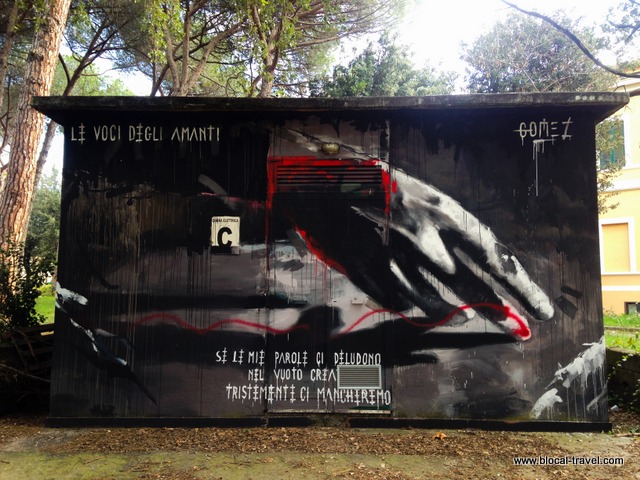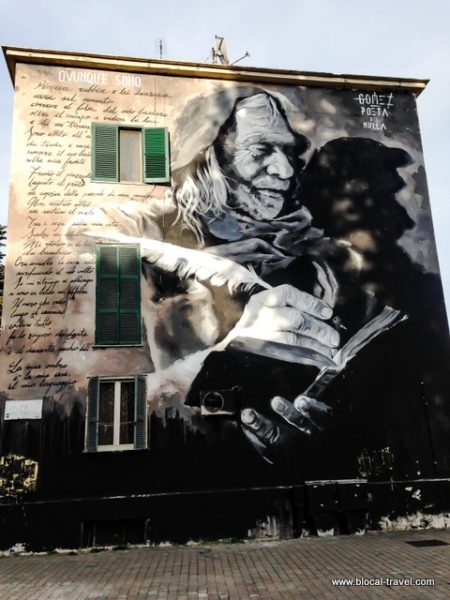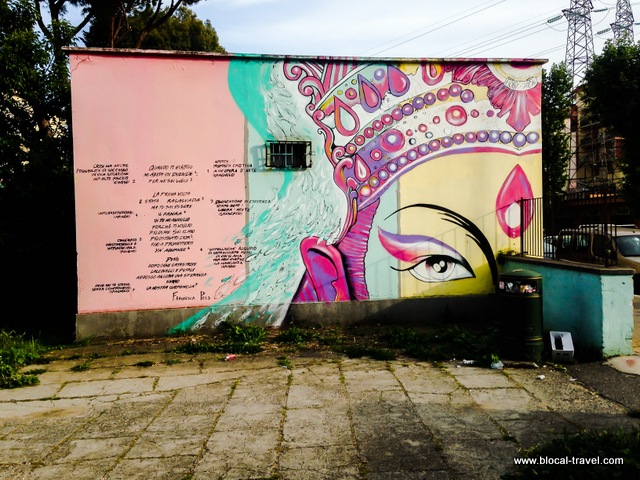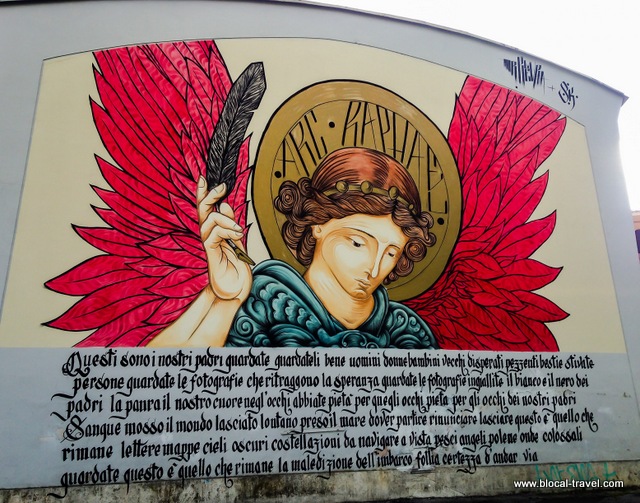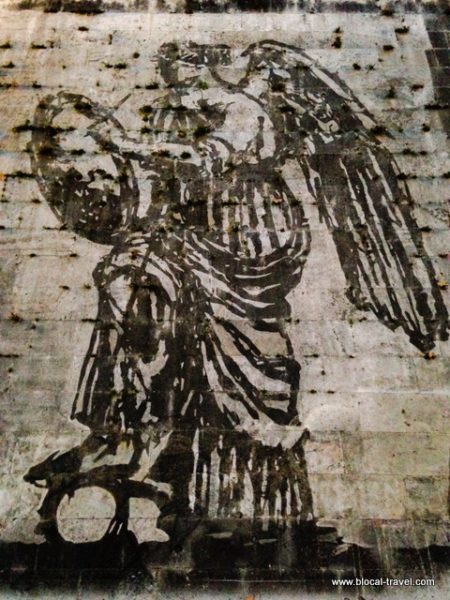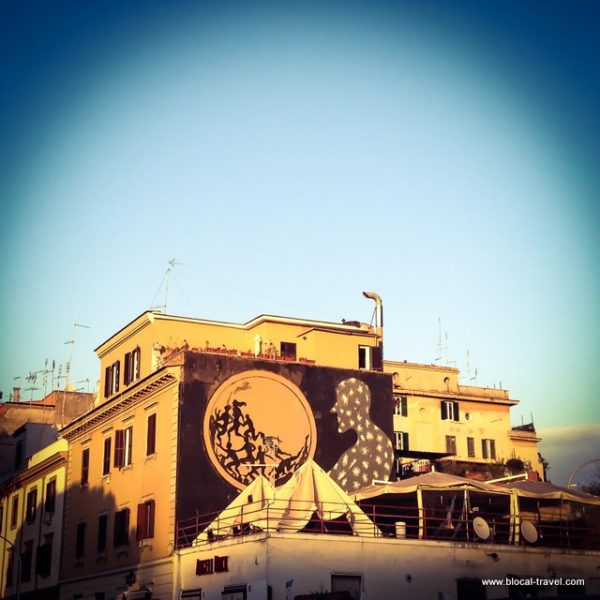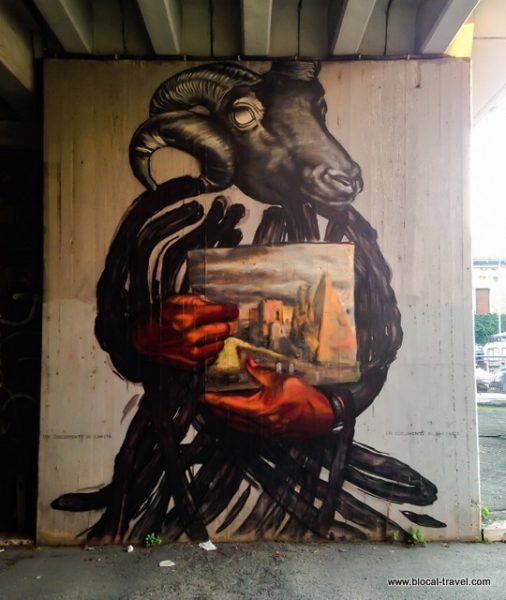As the numbers of legal walls and self-proclaimed art curators slowly increase in the capital, Rome’s street art scene is beginning to attract internationally renowned street artists, curious street art lovers eager to discover a less classical side to Rome, and growing attention from the institutions.
Some of our local artists are now invited to paint abroad, so we can say that Rome’s proverbial parochialism is fading away year after year, although the majority of the works realized on the streets of Rome are still amateurish, especially when compared to those abroad.
But that’s also part of the charm of Rome’s street art scene, a scene that is still very spontaneous and genuine, where passion and creativity win out over grants and investments in culture, technical skills and proper execution, which –as a matter of fact- would result in bare ornamental painting.
And for us Romans, feelings prevail over form.
- Read also: “Street Art in Rome: A Guide to Ephemeral Art in Italy’s Eternal City” the ultimate travel guide to the top 26 neighborhoods to find street art in Rome, with handpicked local tips to eat, drink and shop in Rome like a local.
Street Art in Rome > PRIMAVALLE
Primavalle is a former rural area in the western outskirts of Rome that, during the Fascist era, was turned into a council housing ‘hood. Here, in 2015, the writer Maurizio Mequio (a.k.a. Poeta del Nulla) launched Muracci Nostri, a grassroots, crowd-funded street art festival that attracted more than 50 artists. This project is extremely genuine and artistically naïf, strongly rooted in the local community.
My favourite wall is the one by the Venezuelan artist Luis Gomez de Teran, whose black-and-white portraits inspired by Caravaggio are now mushrooming around Italy. In this work, titled “Raccontami una storia” (tell me a story), Gomez depicted two women shrouded, almost sheltered, in darkness -as his characters always are.
Nearby, there is a pregnant wonder woman by Flavio Solo and a work by Omino71 depicting the actress Ingrid Bergman, who starred in some scenes of Rossellini’s “Europa 51” that were shot here.
A bit farther on, an ironic Maupal plays with the wall assigned to him by painting two prisoners, “Hope” and “Dream”, in the act of crossing it.
But the real gems of the area are two large-scale murals painted under the supervision of the art gallery Varsi, as “promo-teasers” of two shows that took place at the gallery in 2016.
The one by the Australian Fintan Magee (one of my favourite street artists, even more so after meeting him at Nuart 2016!) depicts a woman staring at the horizon and holding a deer’s head. The wall is inspired by Fintan’s childhood and the place where he spent it (the outskirts of Brisbane), where he recalls a car accident caused by a deer crossing the street. In this work, he questions the ethics of hunting and wonders about the equilibrium of nature. He takes the issue from a real world -where deer brought to Australia by Europeans are in conflict over the same food with the more aboriginal kangaroos and are therefore despised and hunted by locals- and sets it into a dreamlike, suspended world where the border between life and death is erased.
Read also: The art of Fintan Magee, a leading figure in Australian street art
The other mural is by Pixel Pancho and depicts the Greek myth of Theseus stabbing the Minotaur as part of his series of encounters between robots and gods. They both look like robots, iconically showing their wheels, rust and iron like all the characters painted by the artist. This mural was painted with brushes, hence the minute details that mesmerize the observer.
Street Art in Rome > SANTA MARIA DELLA PIETA’
Still part of the project Muracci Nostri is the revamping of some buildings inside the park surrounding the former mental asylum of Rome Santa Maria della Pietà. In 2015, the project brought 28 street artists to this forgotten park in the northern outskirts of Rome, among whom Beetroot who drilled his portrait of the poetess Alda Merini, who was internalized in this mental asylum.
Again, my favourite work is the one by Gomez, who painted several intertwined, black-and-white hands accompanied by four messages collectively titled “Lovers’ voices”, which are “se mi allontano, afferrami e sii forte” (if I leave, hold me and be strong), “se mi nascondo, sfiorami e sii gentile” (if I hide, touch me lightly and be kind), “se mi confondo, guidami e sii paziente” (if I get confused, guide me and be patient), “se le mie parole ci deludono, nel vuoto creato tristemente ci mancheremo” (if my words disappoint us, in the emptiness created sadly we will miss each other). To realize this masterpiece, the artist worked together with several patients from some mental-health day-care organizations still operating in the complex.
And here are some more works that you can find in the park:
One year later, which was one month ago, Gomez came back and painted several despairing figures on the façade of the Museum of Psychiatry. It’s amazing to notice how his personal style has grown in just one year!
Street Art in Rome > TRULLO
You already know how much I love this ‘hood of street poets and guerrilla painters, so no wonder that I’m also a big fan of its local street art festival. What I’ve always appreciated about the revamping of Trullo through colours and arts is that it didn’t originate from an art gallery or an administration looking for political consensus, but from its inhabitants who are constantly setting a good example of caring for their common spaces, often at their own expense.
Trullo’s DIY urban renewal involves anyone from youngsters to old people, showing that, if politicians forget about an area, it’s our responsibility as citizens to take care of it.
Read my special street art guide of Trullo neighbourhood in Rome
And so, after the colourful revolution undertaken by Pittori Anonimi del Trullo, in October 2015 the ‘hood welcomed the third edition of the International Street Poetry Festival, which was previously held in Milan (2013) and in Genoa (2014). During the festival, street poets and street artists worked in pairs on huge walls and shop shutters.
My favourite wall is by –guess who?- Gomez –again! ;-)
Here the Venezuelan artist portrayed Mario D’Amico, the founder and painter-in-chief of Pittori Anonimi del Trullo. The associated poetry, written by Poeta del Nulla, is about the power of the shadow as something other than the self.
Another intervention I especially like is the one by the Milanese street artist Piger and the poet Ivan, who covered the local food market with a red-and-blue membrane of letters, a gothic calligraphy encapsulating key-words and poems related to opposition and political resistance.
Other major works are by Jerico, Diamond, Moby Dick, Mr. Klevra and Flavio Solo, who portrayed Laura -a lady from the ‘hood who died recently. Solo, who was also the organizer of the festival, was born in this area and he belongs to the collective of painters who have been renovating the ‘hood since the earliest times of this colourful revolution.
Rome’s street art > WILLIAM KENTRIDGE’s “Triumphs and laments”
[Update 2021: unfortunately this artwork faded away]
This is a single mural and not an area but, as it is 550 meters long, I guess it deserves a whole paragraph to itself. This frieze was created though the erosion of the biological patina on the travertine embankment walls of the Tiber river.
Through this special technique, which –by the way- is reversible through time, the South African artist William Kentridge depicted more than 80 figures illustrating the history of the Eternal City from its foundation to the present.
The work stretches between Ponte Sisto (which connects Trastevere to Campo de’ Fiori) to Ponte Mazzini (connecting Prati to Flaminio), therefore entirely inside the city centre, hence the necessity of using a technique that is temporary.
Street Art in Rome > SAN PAOLO
After being the industrial district of the city, Ostiense reinvented (and rebranded) itself as the street art district of Rome. Last time I wrote about the area around the Gasometer, so this time I’m showing you a few works that are located a bit farther away, that is beyond St. Paul’s outside the Walls.
Actually just opposite the church, there is a work by the Spanish street artist Sam 3, who painted one of his iconic black silhouettes on the upper part of a building. The peculiarity of this work, which was realized for the Outdoor Festival 2012, is that its main character is dotted with stars, rather than a plain black shadow as usual.
On the walls of the nearby underpass leading to the Basilica di San Paolo metro station (Viale Giustiniano Imperatore), there are some works by Diamond inspired by Ovid’s metamorphoses and realized through his unique trait recalling art nouveau and tattoo art.
Still at the same underpass, there are two works by the American street artist Gaia, who has strong links to the city of Rome. This work is titled “Sbudellare la città” (gut the city) and it is uncommonly simple for him.
He usually paints Metaphysical scenarios inspired by Giorgio De Chirico, or by ancient Roman and Greek art, and he uses bright, almost-neon, colours -as you can witness a bit farther on at a gas station on Via Ostiense 333. In this second mural, which was painted in 2013, we can spot several landmarks of the city, such as a statue from the Foro Italico, the “Cloud” building by Fuksas and the façades of both the MACRO museum and the Palazzo dell’Agricoltura in EUR. Gaia always dives into the city where he is invited to paint bringing his vivid impressions back onto the wall through symbols, statuesque figures and architecture. In this case, the artist meditates on Rome’s being so crowded with art and archaeological heritage that it truncates its own urban development.
On the same street, on the walls of the LGBT centre Mario Mieli, there is a double work by the Spanish artist Borondo realized in 2012 for the Outdoor Festival. Borondo moved to Rome to attend the Art Academy several years ago but, despite the fact that he has lived here, there are not so many works by him on the streets of Rome. From his background in painting Borondo created his unique style made of wide and nervous strokes, here depicting a series of naked figures reinterpreting Plato’s myth of Aristophanes.
Street Art at the abandoned factory on Via Tiburtina
If you are into urbex as well, don’t miss an urban exploration of this abandoned factory on Via Tiburtina, where a lot of local street artists have left their marks (among whom, guess who? Yes, exactly: Gomez!) :-)
I’m working on a blogpost on abandoned places in Rome, so more about this location coming soon: stay tuned!
Rome Street Art Map
Find these murals (and many more) in my Rome Travel & Street Art Map!
Do you want a personalised travel itinerary based on your interests and passions?
Then check out my concierge service ;)










